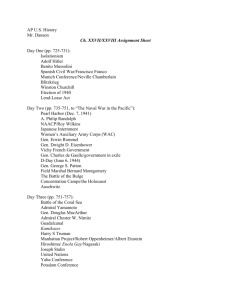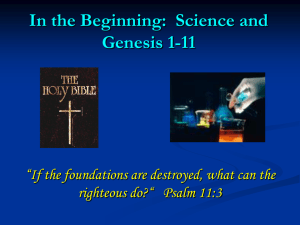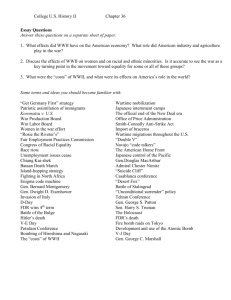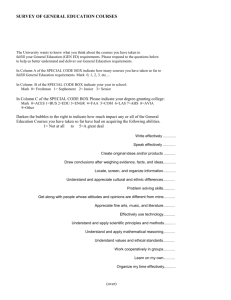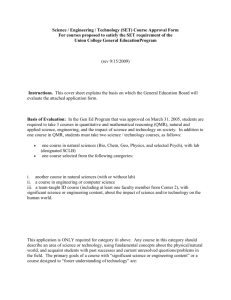Divine Kingship and Genesis 6:1-4
advertisement
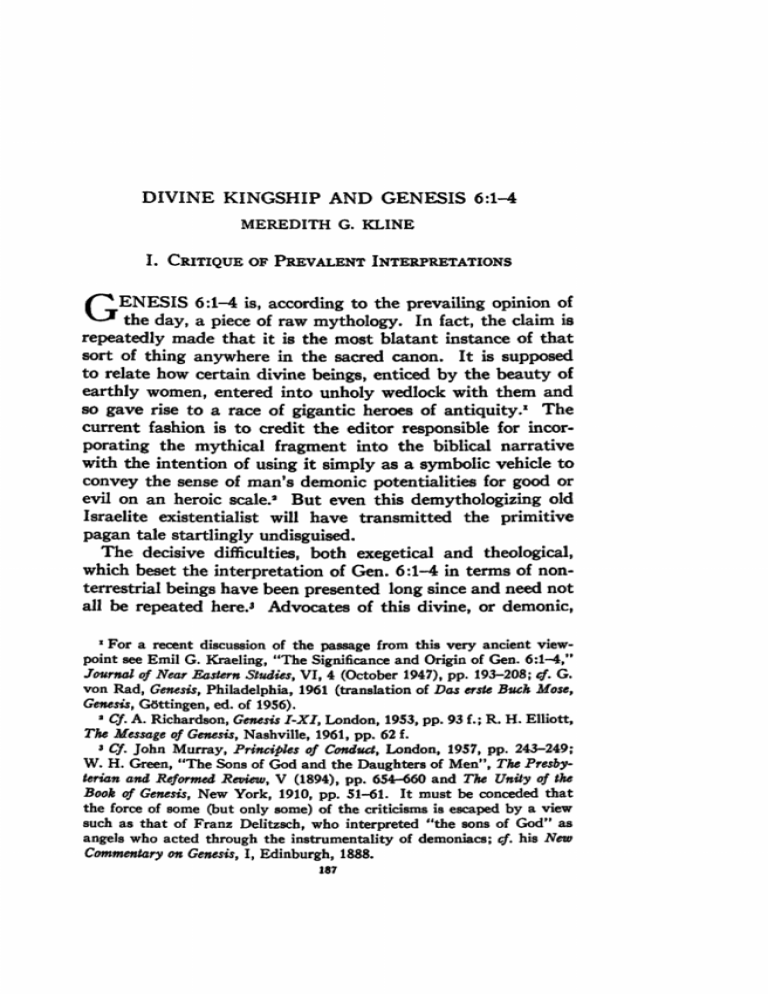
DIVINE KINGSHIP AND GENESIS 6:1-4 MEREDITH G. KLINE I. CRITIQUE OF PREVALENT INTERPRETATIONS Λ ^ ENESIS 6:1-4 is, according to the prevailing opinion of ^ J the day, a piece of raw mythology. In fact, the claim is repeatedly made that it is the most blatant instance of that sort of thing anywhere in the sacred canon. It is supposed to relate how certain divine beings, enticed by the beauty of earthly women, entered into unholy wedlock with them and so gave rise to a race of gigantic heroes of antiquity.1 The current fashion is to credit the editor responsible for incor­ porating the mythical fragment into the biblical narrative with the intention of using it simply as a symbolic vehicle to convey the sense of man's demonic potentialities for good or evil on an heroic scale.* But even this demythologizing old Israelite existentialist will have transmitted the primitive pagan tale startlingly undisguised. The decisive difficulties, both exegetical and theological, which beset the interpretation of Gen. 6:1-4 in terms of nonterrestrial beings have been presented long since and need not all be repeated here.3 Advocates of this divine, or demonic, 1 For a recent discussion of the passage from this very ancient view­ point see Emil G. Kraeling, "The Significance and Origin of Gen. 6:1-4," Journal of Near Eastern Studies, VI, 4 (October 1947), pp. 193-208; cf. G. von Rad, Genesis, Philadelphia, 1961 (translation of Das erste Buch Mose, Genesis, Göttingen, ed. of 1956). a Cf. A. Richardson, Genesis I-XI, London, 1953, pp. 93 f.; R. H. Elliott, The Message of Genesis, Nashville, 1961, pp. 62 f. 3 Cf. John Murray, Principles of Conduct, London, 1957, pp. 243-249; W. H. Green, "The Sons of God and the Daughters of Men", The Presbyterian and Reformed Review, V (1894), pp. 654-660 and The Unity of the Book of Genesis, New York, 1910, pp. 51-61. It must be conceded that the force of some (but only some) of the criticisms is escaped by a view such as that of Franz Delitzsch, who interpreted "the sons of God" as angels who acted through the instrumentality of demoniacs; cf. his New Commentary on Genesis, I, Edinburgh, 1888. 187 188 WESTMINSTER THEOLOGICAL JOURNAL invasion view have themselves been most disturbed by the exclusive attention paid to "man" and to him as a creature of "flesh" in the verdict of God pronounced against the sin of "the sons of God" (vs. 3). The obvious awkwardness of this for the view that the chief offenders under judgment were non-human, incorporeal beings has encouraged doubts as to the propriety of the present location of verse 3. It has been conjectured, for example, that verse 4 ought to follow immediately upon verse 2; then the condemnation of "man" (vs. 3) might be related to the Nephilim-Gibborim (vs. 4), who were the at least half-human and quite corporeal offspring of "the sons of God".4 But for all who are concerned with interpreting the meaning of the author of the narrative in its canonical form (and there is no objective evidence that the Masoretic text differs significantly from the original) it is apparent that the verdict of verse 3 refers primarily to the activity of "the sons of God" (vs. 2), and that precludes all likelihood that the author regarded the latter as preternatural spirits.5 Except perhaps for the fact that "sons of God" often denotes angels in the Old Testament6 and practically equivalent terminology is used for minor deities in extra-biblical literature,7 what has contributed most to the continuing dominance 4 Cf. Kraeling, op. cit.; von Rad, op. cit. Other textual rearrangements have been suggested. For example, only verses 1 and 2 are original (J1) and these were first located in Gen. 11 before vs. 4, but then moved by J2 to a position after vs. 8. Later they were re-located by the priestly redactor in their present position and supplemented with the groundwork of verses 3 and 4. Cf. C. Simpson, The Book of Genesis, The Interpreter's Bible, I, Nashville, 1952, p. 533. s Even on the interpretation that possessed men were the instruments of demons (cf. note 3), it would not be the possessed humans but the demons who were the agents with primary responsibility and the chief objects of the divine displeasure, as one may judge from the encounters of our Lord with demoniacs as related in the Gospels. K. Rabast, recognizing the difficulty, would salvage the angel interpretation by the implausible suggestion that verses 1 and 2a describe a sin of angels, but verse 2b (assuming an abrupt change of subject) describes a corresponding sin of men. It would then be the punishment of the latter only which it is mentioned in verse 3. Cf. his Die Genesis, Berlin, 1951, pp. 130 ff. 6 See Job 1:6; 2:1; 38:7; cf. Pss. 29:1; 89:7. 7 Cf. the bn Urn of the Ugaritic texts, the bn 'lm of the Azitawadd inscription, and the D^N p of the Incantation of Arslan Tash. DIVINE KINGSHIP AND GENESIS 6:1-4 189 of the mythical (or at least angelic) interpretation of the passage has been the absence of a satisfactory alternative.8 On the orthodox side, the view apparently generally held today is that which has long been popular in the church and among some Jewish interpreters, namely, that "the sons of God" and "the daughters of men" represent respectively the Sethite and Cainite lines which are set in contrast to one another as the godly and the ungodly in Genesis 4 and 5. The sin of "the sons of God" was then their failure to marry within the covenant.9 Therein is said to lie the explanation of the otherwise unexplained development that degeneracy prevailed universally outside the family of Noah, the Sethite line being scarcely able to preserve its specific covenantal identity in the face of the advancing tide of Cainite ungodliness. This view has the advantage of doing justice to the terms of the verdict of verse 3 by understanding all parties to the sinful marriages as human beings. Against it, however, the serious objection has been directed that it takes CT^n in two different senses in verses 1 and 2. In verse 1 it understands D 1$Ü a s mankind generically; in verse 2, as the Cainite line specifically. That such a shift in meaning is certainly not intended becomes apparent as soon as one observes that the "men" of both verses are identified as the fathers of the "daughters" of the two verses and surely the "daughters" of the two verses are identical. This difficulty can, however, be overcome in such a way that an interpretation of at least the same general tenor remains as a plausible possibility. It is necessary simply to regard 0*Τ$Π as generic in verse 2 as well as in verse 1 where it is certainly so. There would then be no specific reference to Cainite women. But the sin of the Sethite men, "the sons of God", would on this modified approach still be their failure to show covenantal discrimination in their selection of mar­ riage partners inasmuch as they made their choice out of the generality of women according to their own unrestricted pleasure. The emphasis would now fall on ΗΠ3 Ί#Κ /So, 8 Although Rabast (idem) suggests what he deems a possible solution, he declares after his survey of the standard interpretations that the passage remains an unsolved enigma. 9 Cf. Gen. 24:3, 4; 26:34, 35; 27:46; 28:1, 2, 6-8; 34. 190 WESTMINSTER THEOLOGICAL JOURNAL the 19 being partitive, i. e.t they selected mates out of the category "any that they chose", or possibly explicative, i. e.t "even all that they chose". Their choice would of course often be a Cainite woman, but even when they chanced to select a Sethite woman they only chanced to select a covenant woman and so did not act in conscious fidelity to the covenant but in careless independence of its holy requirements. But a yet more serious problem is posed for any variety of the prevalent orthodox view by verse 4 if the NephilimGibborim there referred to are the offspring of the marriages of "the sons of God" and "the daughters of men". For it is not at all clear why the offspring of religiously mixed marriages should be Nephilim-Gibborim, however these be understood within the range of feasible interpretation. Now it is unwarranted to suppose as some have that our passage was designed to serve primarily as an aetiological story accounting for the origin of the Nephilim. But on the other hand, difficult though the verse is, we must agree with the judgment expressed by Dillmann: "That the Nephilim were the fruits of those marriages is certainly the meaning, and is also clearly evident from '311 ÌNÌ2J ΙφΚ".10 For if the author's intention had been to say nothing more than that the NephilimGibborim were contemporary with the marriages mentioned, he would have simply referred to those marriages in language similar to or even identical with that in verse 2. But his reference to the conjugal act and to childbearing finds justi­ fication only if he is describing the origin of the NephilimGibborim." Unless the difficulty which follows from this conclusion can be overcome, the religiously mixed marriage interpretation of the passage ought to be definitely aban­ doned." The traditional ecclesiastical view has also been criticized for interpreting "the sons of God" in a spiritual sense, i. e., » Genesis, I (1897), p. 241. 11 It is not necessary to the above interpretation but 'y\ jn$3 ViJ O'Vw may be translated: "The Nephilim arose [rather than "were"] in the earth in those days . . . when, etc." For such a rendering in sentences of similar construction, cf., e. g., Gen. 7:6, 10; 15:17. " Cf. Rabast, idem. DIVINE KINGSHIP AND GENESIS 6:1-4 191 godly men. For one thing, a specific part of the genus is thus set in contrast to the genus itself, i. e., godly men over against men. Other examples of that sort of thing can, however, be 13 cited. There is also the question of whether a reference to spiritual sonship would not be anachronistic in Genesis 6. But it cannot be demonstrated that the concept of man as a spiritual son of God was unknown in the antediluvian period. Moreover, the terminology in Gen. 6:2 need not reflect the thought or language of any earlier stage in revelation than the time when this inspired interpretation of the antediluvian history was produced in its Pentateuchal form, and the idea of spiritual sonship is found elsewhere in the Pentateuch.14 Nevertheless, the use of the designation "sons of God" for members of the covenant community would be isolated in the context of the Book of Genesis and would moreover be so remarkable as to demand a more plausible explanation for its appearance there than can be readily discovered. One is constrained to seek for some other interpretation of the II. DIVINE KINGSHIP Is not the key to the identity of the D'flfrlflJ"^? provided by the sacral kings who are so much in the center of interest in current studies of ancient Near Eastern life and culture? From the several great kingdoms which formed the setting of Old Testament history the evidence has been amassed, show­ ing that kings were often regarded as in one sense or another divine and that they were indeed called sons of the various 13 Cf., e.g., Gen. 14:16; Ps. 73:5; Isa. 43:4; Jer. 32:20. "The explanation lies in the circumstance that in such cases the whole is thought of as having only the generic characteristics and nothing more, whereas to the part a certain distinction is attributed which raises it above the genus, to which nevertheless logically it belongs' ' (G. Vos, Biblical Theology, Grand Rapids, 1954, p. 60). κ Cf. Deut. 14:1; 32:5, 6. On Exod. 4:22 see below. 192 WESTMINSTER THEOLOGICAL JOURNAL gods.15 An especially interesting example comes from the Ugaritic epics where king Krt is called krt bn il.16 From the titulary of this pagan ideology of divine kingship the term D,n7NîT,,;D was appropriated in Gen. 6:1-4 as a designation for the antediluvian kings. It is accordingly to be translated, "the sons of the gods".17 By this simple literary stroke the author at once caught the spirit of ancient paganism and suggested darkly the satanic shapes that formed the background of the human revolt against the King of kings. For these "sons of the gods" were of all the seed of the serpent most like unto their father. One brief title thus serves to epitomize the climactic developments in the history of man's covenant breaking during those generations when the judgment of God was impending by which the world that then was perished. It has been a merit of some who have thought that they found in this passage a preternatural intrusion into earthly history, a sort of pseudo-messianic embodiment of demonic spirits in human flesh, that they have sensed more x * For the evidence see such standard treatments as I. Engnell, Studies in Divine Kingship in the Ancient Near East, Uppsala, 1943; H. Frankfort, Kingship and the Gods, Chicago, 1948; J. de Fraine, VAspect religieux de la royauté Israélite, Rome, 1954; A. R. Johnson, Sacral Kingship in Ancient Israel, Cardiff, 1955; Myth, Ritual, and Kingship, éd. S. H. Hooke, Oxford, 1958; and La Regalità Sacra — The Sacral Kingship (Studies in the History of Religions IV), Leiden, 1959. 16 Gordon, Ugaritic Handbook, 125:20. In this passage, which describes the mourning over the sick king, there is voiced the question raised by the prospect of the death of a divine being. "How can it be said, 'Krt is a son of El, the offspring of L^pn and Qd§?' Or do gods die, the offspring of Ltpn not live?" (lines 20-23). 17 There is no more theological difficulty in this than there is in the ad hominem objectification of the gods of the nations which is common in the Old Testament. Another biblical instance of such usage is probably found in Ps. 138:1. "Before the gods [û'rrt?^] will I sing praise unto thee." The context indicates that these D'rrt^ are the Gentile rulers; see verse 4 and compare Ps. 119:46. The addition of ' j ^ in Genesis 6 does not alter the sense radically, if at all. It could be a case of ja used to denote an individual of a particular class. Cf. the parallelism of D'ï^gl anc * *3? ]V^y in Ps. 82:6. Or the use of ]3 in Genesis 6 might be to reflect the claim of the heathen kings to divine paternity rather than their claim to divinity as such. In either case, the addition of *J3 in Genesis 6 would also achieve a better verbal balance and a more complete conceptual contrast with the ΌΓ\φ$ nlí^l, "the daughters of men". DIVINE KINGSHIP AND GENESIS 6:1-4 193 fully than the advocates of the traditional exegesis, the titanic, one might almost say the eschatological, character of this ancient crisis. Still interpreting the D^n^NJpjD as kings, it is also possible to regard that designation not as a direct appropriation from the pagan titulary but as a genuinely theistic expression honoring these potentates in their office as "the sons of God".18 The kings' own self-designation as the son of this or that god will still have supplied the inspiration for our author's use of D'H^^TJ^ja, but as it stands in Genesis 6 the expression will be an adaptation, reinterpreting the kingly dignity for what it is in truth. "For they are God's ministers", Paul could say even in the days of the D'ïT/KrPJD who ruled from Rome (Rom. 13:6). Support for the interpretation of the 0,Π7^Π",33 as kings is found in the use of similar titles for theocratic rulers in Israel. In the Book of the Covenant those who administer justice as the representatives of God are called Ο'ΓΡΝ.1* Particularly important is the evidence of Psalm 82. There the Israelite magistrates, because of their God-like dignity and authority, and in spite even of their malfeasance (vss. 2 ff.) which brings upon them a divine warning of their mortality (vs. 7), are called Ο'Π^Κ (vss. 1, 6) and in synon­ ymous parallelism with that in verse 6, l^^V '3? "sons of the Most High".20 Similarly, the scion of David is heir to the divine promise: "I will be his father and he shall be my son".21 «· Cf. Rom. 13:7. x 'See Exod. 21:6; 22:8, 9, 28 (Heb. 7, 8, 27). Particularly significant is the parallelism in 22:28 between OVÍVK and τ\φν$ K'fety "the ruler of thy people". (Cf. Acts 23:5.) This contradicts the suggestion that D'fl^g in these passages denotes sacred images such as were used in court ordeals elsewhere; cf. C. H. Gordon, "ΰ'Π^Κ in Its Reputed Meaning of Rulers, Judges'1, Journal of Biblical Literature, LIV (1935), pp. 139-144. The same perspective is found in the Deuteronomic stipulations (19:17) where to stand for judgment "before the Lord'* is explained by the appositional "before the priests and the judges". »° Cf. John 10:34, 35. « II Sam. 7:14. Cf. Exod. 4:22 f., where God's identification of Israel as "my son" seems to signify Israel's royal status as heir of the kingdom of God. That is suggested by the contrast drawn between Israel, God's firstborn son, and Pharaoh'sfirstborn,who was of divine birth according 194 WESTMINSTER THEOLOGICAL JOURNAL And that covenant is fulfilled uniquely in him whom the Father 2a sanctified and sent into the world, the messianic Son of God. On the basis of such biblical usage the view anciently arose among the Jews that the D'il"/^rpjD °f Genesis 6 were men of the aristocracy, princes and nobles, in contrast to the socially inferior ''daughters of men". This interpretation came to expression, for example, in the Aramaic Targums23 and in the Greek translation of Symmachus24 and it has been followed by many Jewish authorities down to the present.25 Always lightly dismissed in critical surveys of the long debate over the exegesis of Gen. 6:1-4, this Jewish view was indeed defici­ ent as a total assessment of the Genesis 6 crisis. In particular, it failed to recognize the precise nature of the transgression of the D'H^^JJ"^?. Nevertheless, it alone of all the views was on the right track, only wanting the necessary substantiation and a correct orientation. That the clue to a similar but more precise and comprehensive solution of the ancient mystery of the O'rib^rp}? has now been made available by the studies in divine kingship would have been more readily recognized had not the mythical view of Gen. 6:1-4 become in the mean­ time so unquestioned a tenet of critical Old Testament scholarship. III. DYNASTY OF TYRANTS It is the genealogical nature of the treatment of the ante­ diluvian history that accounts for the focusing of attention on the marriages of the royal Β'Π'ονΓ'ΐ?· The precise character of these marriages and especially of the sin involved in them can best be seen if Gen, 6:1-4 is viewed in relation to the preceding context. The beginnings of the genealogical history of the O^/fcJEHJ? are found in the genealogy of Cain (4:16-24). Significantly, at the very outset of Cain's genealogy the to Egyptian king ideology and so one of "the sons of the gods". «C/. Pss. 2:6, 7; 45:6; 110:1. ·* The Targum of Onkelos renders Ν*3Ί3Ί '331· * ol viol των δνναστηυόντων. as Cf., e. g., The Soncino Chumash, ed. A. Cohen, in loc. DIVINE KINGSHIP AND GENESIS 6:1-4 195 origin of city organization is noted (Gen. 4:17). It was precisely in the urban political unit that the stage was set for the emergence of kingship.36 What, therefore, begins as the genealogy of Cain becomes in the course of its development the dynasty of Cain. In Cain's dedication of his city to the name of his heir there was foreshadowed the lust for a name that was increasingly to mark these city rulers until, when the city-states began to be theocratically conceived, they esteemed themselves veritable sons of the gods, and so "men of name" (Gen. 6:4) indeed. Outstanding representative of the Cainite dynasty was Lamech. Concerning his court life it is recorded that he practiced bigamy (Gen. 4:19) and of his royal enforcement of law it is witnessed out of his own mouth that his policy was one of tyranny, a tyranny that reckoned itself through the power of the sword of Tubal-cain more competent for vengeance than God himself (Gen. 4:23, 24). With this portrait of the kingship of Cainite Lamech the dynastic genealogy of Cain breaks off so that the genealogy of Seth may be given (Gen. 4:25-5:32). But then Gen. 6:1-4 resumes the thread of the history where it was dropped at Gen. 4:24. Structurally, the accounts of Lamech (Gen. 4:1924) and of the D'ÍÍ^JJ-T? (Gen. 6:1 ff.) are much alike. In each case there are the taking of wives, the bearing of children, and the dynastic exploits. The one passage closes with the boast of Lamech concerning his judgment of those who offend him; the other issues in the Lord's announcement of the judgment he purposes to visit on the earth which has become offensive to him. Gen. 6:1 ff. simply summarizes and concludes the course of dynastic development which had already been presented in the individual histories of the several rulers, indicating how the evil potential of Cainite kingship, betrayed even in its earliest beginnings, was given such full vent in its final stages as to produce a state of tyranny and corruption intolerable to the God of heaven. Accordingly, the sinfulness of the marriages described in Gen. 6:1, 2 was not that they were mixed — whether the 36 For the conjunction of the origins of kingship and cities in the SumeroBabylonian sources see below. 196 WESTMINSTER THEOLOGICAL JOURNAL mixture be regarded as a mixture of two worlds (as on the angel view) or of two religious communities (as on the Sethite view) or of two social classes (as on the old Jewish view).27 The sin was that of Cainite Lamech, the sin of polygamy, particularly as it came to expression in the harem, characteristic institution of the ancient oriental despot's court.28 In this transgression the D'nVNrHjn flagrantly violated the sacred trust of their office as guardians of the general ordinances of God for human conduct.29 The princes born into these royal houses of the D^ríbtfrHja were the Nephilim-Gibborim (vs. 4), the mighty tyrants who Lamech-like esteemed their might to be their right. So as man abounded on the face of the earth (vs. 1) God saw that the wickedness of man abounded in the earth (vs. 5). By reason of the polygamy and tyranny practiced by the dynasty of the D^ri/^rpja in the name of divine-royal prerogative and justice, the earth became corrupt before God and filled with violence (vss. 5-7, 11-13) and so hasted to destruction. The validity of this interpretation of Gen. 6:1-4 as the culmination of the antediluvian kings' outrage against God may be tested by a comparison of the biblical narrative with the Sumero-Babylonian flood tradition. Such a comparison will also be found to have relevance for the question of whether this passage is an integral part of the history leading to the flood or whether, as popular critical opinion has it, it was originally a postdiluvian tradition.30 a * There was, of course, nothing inherently improper in a mixed marriage of the type involved on the old Jewish view. a8 Cf. Kraeling's comment on verse 2b: "A polygamous situation is implied in these words" (op. cit., p. 197). Cf. Rabast, op. cü., p. 132. Translate npa Ί0£ ^äö, "even all that they chose", the ]D being explicative; cf. Gen. 7:22; 9:10; Lev. 11:32. Verse la, "when man began to abound on the earth", is a more apt introduction to verse 2 if the sin there described is polygamy than if it is some sort of mixed marriage. 99 The description of their self-indulgence in defiance of the divine appointment (cf. Gen. 2:21-24) recalls that of beguiled Eve (cf. Gen. 3:6 and 6:2). 3° Kraeling, who grants that from its original inclusion in what he analyzes as the source J 1 Gen. 6:1-4 was an episode preparatory to the flood, states that in this judgment he finds himself "running counter to the DIVINE KINGSHIP AND GENESIS 6:1-4 197 The flood story as narrated by Utnapishtim to Gilgamesh (in Tablet XI of the Gilgamesh Epic) begins with a reference to the flood hero's city of Shurippak, of which it is affirmed that it was old "and the gods were in its midst".31 But no explanation is given of what led the great gods to send the flood. Something on this subject is, however, found in the Old Babylonian flood epic commonly called after the hero, The Atrafcasis Epic. The first fragment, containing part of the introduction to the flood, begins: "The land became wide, the peop[le became nu]merous, the land bellowed like wild oxen. The god was disturbed by their uproar. [Enlil] heard their clamor (and) said to the great gods: Oppressive has become the clamor of mankind. By their uproar they prevent sleep'."32 Alexander Heidel's observation is correct that the manner in which this epic begins with a reference to the population increase is "a point in favor of treating Gen. 6:1-4 not as a separate fragment but as the introduction to the story of the deluge, regardless of whether the biblical account is dependent on the Babylonian or whether both have a common origin".33 A further point of similarity to Gen. 6:1-4 in the Atrafcasis Epic is that a period of grace is given to man, during which men are visited with a series of monitory plagues.34 almost unanimous opinion of Old Testament scholarship" (op. cit., p. 195). The majority, following Wellhausen and Budde, has regarded Gen. 6:1-4 as an aetiological legend purporting to account for the Nephilim of Num. 13:33; and they have, therefore, concluded that originally it was a story dealing with postdiluvian times, since if antediluvian the Nephilim would have been wiped out in the deluge. (The ingenuity of some Jewish exegetes would overcome such a problem by the assumption that the Nephilim strain was preserved through the deluge in the persons of Noah's daughtersin-law. Cf. The Soncino Chumash, in loc.) 31 Line 13. On Shurippak as the last center of kingship and cult before the flood see below. a* Column 1, lines 2-8. Translation of E. A. Speiser in Ancient Near Eastern Texts (ed. J. B. Pritchard), Princeton, 1950, p. 104. 33 The GUgamesh Epic and Old Testament Parallels, Chicago, 1949, p. 226, n. 2. s* Cf. Gen. 6:3; I Pet. 3:19, 20. The reference to the one hundred and twenty years in Gen. 6:3 is, of course, one of the clearest marks of the passage as a prelude to the flood judgment, if the verse is recognized as original and it is interpreted as setting a temporal limit to the divine forbearance with men. 198 WESTMINSTER THEOLOGICAL JOURNAL A valuable contribution to our knowledge of the principal themes, particularly the introductory themes, of the ancient flood traditions is made by the Sumerian Deluge account, found on a fragmentary tablet at Nippur. The preserved portion of the first column deals with the creation. Then after a break the second column relates that kingship was lowered from heaven and that five cities were founded and apportioned to particular gods.35 When the text continues on the third column after another lacuna, the subject is the flood itself. Further light is shed on the contents of the important second column by the closely related antediluvian preamble of the Sumerian King List.36 That list begins, "When kingship was lowered from heaven", and it goes on to state that kingship was successively at five cities, the same as those mentioned in the Sumerian Deluge text. The kings who ruled at each of these royal centers are named and the phenomenal lengths of their reigns given. Thus, for example: "(In) Bad-tibira, En-men-lu-Anna ruled 43,200 years; En-men-galAnna ruled 28,800 years; the god Dumu-zi, a shepherd, ruled 36,000 years. Three kings (thus) ruled it for 108,000 years."3* This section of the king list concludes: "These are five cities, eight kings ruled them for 241,000 years. (Then) the Flood swept over (the earth)."38 ss The cities are Eridu, Bad-tibira, Larak, Sippar, and Shurippak. 36 See Thorkild Jacobsen, The Sumerian King List, Chicago, 1939, pp. 58-61. *i Translation that of A. Leo Oppenheim in Ancient Near Eastern Texts, p. 265. 38 Idem. In this connection, the conclusion of Kraeling may be noted that the Gibborim of Gen. 6:4 "are a Western adaptation of the Babylonian tradition of the antediluvian kings" (op. cit., p. 200). We do not agree with the way he reconstructs the literary relationship and do not accept the exegesis of his supporting argument, i. e., that Gen. 6:3 is the Yahwistic contradiction of the immensely long lives attributed to the kings by the polytheistic source. But Kraeling is correct in detecting an historical parallel in the two passages. Incidentally, the longevity theme is in the Bible explicitly associated with the Sethite line and we suspect that this genealogy too is, or at least becomes in its later stages, dynastic. The Sumerian Noah, Ziusudra, appears as a king in the Sumerian Deluge account. As kings the Sethites would also be D'ïjfreïPS» in the sense of "sons of God". They could not, however, be identified with the dynasty of corruption and oppression described in Gen. 6:1 ff. DIVINE KINGSHIP AND GENESIS 6:1-4 199 It appears then that the theme of antediluvian kingship centering in cities under the hegemony of various gods constituted the main introductory motif in the SumeroBabylonian flood traditions. This kingship was of heavenly origin and significantly it numbered a god among its representatives.39 Now it is evident that our interpretation of the O'O'NrpjD of Gen. 6:1-4 as sacral kings in a dynasty reaching back into the Cainite genealogy of Genesis 4 provides a theme which parallels this major motif in the Sumero-Babylonian antediluvian traditions. For all who are familiar with the way in which Genesis repeatedly is found to share the formal thematic interests of other ancient literature the parallelism just noted should be persuasive evidence that our interpretation is in its basic orientation sound. Or, to state the corollary, the fact that an historical theme so prominently treated in the Sumero-Babylonian epic tradition finds no counterpart in Genesis 3-6 according to the standard interpretations is itself good reason to suspect that these interpretations have been missing the point.40 And in addition to corroborating the interpretation of Gen. 6:1-4 in terms of divine kingship, the thematic parallelism which is thus discovered between the biblical and extra-biblical antediluvian accounts offers, in contradiction to the subjective surmisings of the documentary theorists, convincing confirmation of the integrity of the passage within the antediluvian context. IV. KINGSHIP FROM ADAM TO ABRAHAM It may be useful to observe the kingship theme of Gen. 6:1-4 in the perspective of its broader development in the early chapters of Genesis. 39 The god Dumu-zi (i. e., Tammuz) is listed; cf. column I, line IS. Dumu-zi reappears as one of the postdiluvian kings, along with other divine or partly divine beings like "the god Lugal-banda" and "the divine Gilgamesh" (cf. column III, lines 12-20). 40 Attempts have been made to equate many of the names in the antediluvian genealogies of the Bible with those in the extra-biblical king lists. But even if this effort is in a measure successful, it comes short of finding an explicit reference to kingship in these biblical passages, much less of finding in kingship the dominant theme preparatory to the flood. In particular, the climactic introductory episode of the D'iÎ^îJ"1^ *s st*^ left standing unrelated to the kingship motif. 200 WESTMINSTER THEOLOGICAL JOURNAL To the God-like one among his creatures the Creator as­ signed the dignity of kingly dominion over all other creatures and commissioned him with the royal mandate to subjugate and cultivate the earth (Genesis 1 and 2). This kingdom pro­ gram was to be executed through the basic institutions of marriage and labor. Through these the earth was to be filled with a race of gifted rulers who would exercise their steward­ ship of talent and dominion in the perfecting of the consecra­ tion of all sub-human creation to the interests of man, as the royal representative and priest of God. This program was reinstituted after the Fall with the intimation given that it would be realized as a soteric accomplishment of the Lord (Genesis 3). At the flood, which terminated the first great historical epoch, the royal mandate may be seen fulfilled after a figure. For within the ark there was found the paradisaical kingdom of God renewed in miniature, with regal Noah, scion of Seth's faithful dynasty, together with his princely heirs established in dominion over the representatives of all the sub-human creation and triumphant over the natural elements. And from the ark the loyal covenant servant emerged as the redeemed king into the new world, cult-centered and rainbowcrowned (Genesis 5, 7, and 8). Over against this realization of the royal ideal by means of the soteric intervention of God, there is set the failure of the royal enterprise as conducted by the dynasty of Cain. Within this succession of the ΰ'Π^ΚΓΡίΠ, the marriage ordinance was desecrated and the extension of dominion was sought by violence rather than through godly labor. But though they exalted themselves against the heavenly King, their breath was in their nostrils and their regal aspirations to divinity perished in the same waters of divine vengeance which bore the righteous king into his new world (Genesis 4, 6, and 7). The history of kingship from the flood to Abraham as described in Genesis 9-12 repeats the antediluvian pattern found in Genesis 3-8. Man was again commissioned to the kingdom program and enthroned as lord over all the lower orders (Gen. 9:1 ff.). Even the special office of king was specifically provided for in that the human community was invested with the power of the sword for the punishment of DIVINE KINGSHIP AND GENESIS 6:1-4 201 all who shed man's blood, whether the man-slayer be "any kind of beast" or a fellow man, and so a "brother" of the slain (Gen. 9:5, 6; cf. 4:15, 24).*' Once more too the mystery of iniquity developed in this new aeon towards a climactic episode of defiance against the God of heaven. The author begins to trace this theme in Gen. 9:20 ff., as he had in Gen. 4:3 ff., with the record of a transgression by a son of the covenant patriarch which issued in an echo of the primeval curse (Gen. 9:25; cf. 4:11; 3:14). He continues, as he had in Gen. 4:16 ff., with a survey, within a genealogical framework, of the cultural-political advance of mankind outside the covenant community (Gen. 10:1 ff.). It presently appears that kingship was again "lowered from heaven" in the postdiluvian period. In the midst of the Genesis 10 survey there looms the figure of Nimrod in whom the climactic Babel episode is anticipated and possibly even individualized (vs. 8), so providing a parallel to the relation­ ship which obtains between the figure of Lamech (Gen. 4:19 ff.) and the irreligious dynasty of Gen. 6:1-4. The account of Nimrod is of particular interest for the interpretation of Gen. 6:4 because he is described as one belonging to the category of the Gibborim (Gen. 10:8). That Nimrod was a king is clear from Gen. 10:10 (which locates his dominion in the land of Shinar, cf. Gen. 11:2), and this sup­ ports the interpretation of the Gibborim of Gen. 6:4 and their fathers, the D'rpgjpja, as a royal dynasty. If one bears in mind the divine ordinance of Gen. 9:5, 6, by which the civil «J "His brother" (rn$) in Gen. 9:5 does not denote the kinsman avenger as though responsibility were here being laid upon him to over­ take the murderer. Each instance of ]ϋ #"ΠΝ in this verse must have the same force and, as the case of "every kind of beast" clearly indicates, its force is to hold the slayer liable to punishment. The vn$ declares that every murder is like the first murder a case of fratricide. The ϋΊ *ï|9# D "W0 °f v e r s e 6 then summarizes all the manslayers of verse 5, both men and beasts, as this verse goes on to assign to man in his kingly capacity the responsibility for putting all manslayers to death. In view of our thesis that the α'π^ΚΕΓ'Ιφ are kings it is tempting to interpret verse 6b (D"]$£rn$ nfey D'nfrfcJ D^£3 '3) as an appeal to the God-like nature of man as the justification for his executing the divine judgment. But it seems at least as plausible to refer this description to the victim and so find in it a measure of the enormity of the crime of murder. 202 WESTMINSTER THEOLOGICAL JOURNAL power was authorized to destroy manslaying beasts as well as human murderers, it will be seen that Gen. 10:9 need not be judged an interpolation which breaks the thematic unity of verses 8 and 10, simply because it specifies that Nimrod was "P£H¡&?. Nimrod's hunting exploits were not mere sport but a function properly pertaining to his royal office and quite necessary in his historical situation. The ungodly dynasty of human kingship challenged the ordinances of the Creator until at Babel it was ripe for judgment. Gen. 11:1 ff. parallels Gen. 6:1 ff. The spirit of the two is the same; the kingdom builders of Shinar, like the ancient Gibborim, were bent on a name (11:4; c/. 6:4). And of course each episode leads directly to the divine reckoning and intervention. But while there was this rebellious development of human kingship that led on to the judgment of God, the era of Genesis 9-12 like that of Genesis 3-8 moved towards an outstanding realization of a kingship of man which was after God's own heart and towards a significant portrayal of the kingdom of God among men. The earlier age led to Noah and the kingdom in the ark; the following age led to Abraham and the kingdom in the promises.42 The fall of the dynasty of the D*iT/$rP39 was the foil to Noah's triumph. So in contrast to the debacle at Babel there is set the establishment of God's covenant with Abraham as the crowning fruit of the Noahic era, the fruit in which there was in turn the seed of the future of God's kingdom and of a righteous kingship on earth. In opposition to the world center which rose from the accursed ground of Shinar, destined to desolation, there appears in the covenant promises given to Abraham the city of God, which descends from heaven and endures forever. In *a Noah was introduced in a genealogy of the covenant generations which was recorded between the accounts of Lamech and the D'i^^ET'^ (Gen. 4:25 — 5:32) and was resumed after the latter (Gen. 6:9, 10). Similarly, the genealogy that introduces Abraham intervenes between the genealogy in which Nimrod appears and the Babel episode (Gen. 10:21-31) and is resumed after the latter (Gen. 11:10 ff.), although there is minor structural variation at this point. DIVINE KINGSHIP AND GENESIS 6:1-4 203 those promises Abraham possessed a kingdom which was the fulfillment, first in a pre-messianic symbol and afterwards in messianic reality, of the kingdom mandate given to Adam in the Garden of God. Fill the earth and subdue it, was the divine commission given to Adam; thy descendants shall be as the stars of the heaven and they shall conquer and inherit a new paradise land of milk and honey, was the corresponding divine promise given to Abraham. It was in that kingdom of God that true human kingship was to prosper and be perfected. It would produce a kingship not bent on its own name but consecrated to the glory of God. For the covenant by which it was administered was a vassal covenant — a declaration of the lordship of the God who gave it and an establishment of the dynasty of the faithful who received it as servant-kings, vicegerents of the Almighty. In the unfolding of that covenant the ideal of true kingship was ever more clearly delineated. The true theocratic king must not like the D'H^XiJ^ja "multiply wives to himself" (Deut. 17:17). He must not like the Gibborim fill the earth with violence by committing injustice against the weak but rather judge the people with righteousness, break in pieces the oppressor, and redeem the soul of the needy from deceit and violence (cf. Ps. 72). None, however, among the Ο'ΓΤ'$ of ancient Israel actually reigned in perfect righteousness. Some so far fell short that the conditions of Genesis 6 returned in Israel (cf. Ps. 82:1-5) and these "sons of the Most High" had to be warned in words which seem to allude to the verdict and judgment against the prediluvian dynasty of the 0νΤ7ΚΓΗ33: "Ye shall die like men, and fall like one of the princes" (Ps. 82:7; cf. Gen. 6:3 ff.). But it is the confession of the church that the king-ideal has found embodiment in the seed of David whom David called "my Lord" (Ps. 110:1; cf. Matt. 22:43 ff.; Mk. 12:36 f.; Lk. 20:42ff.; Acts 2:33ff.); to whom God declared, "Thou art my Son; this day have I begotten thee" (Ps. 2:7); who was a priest-king after the order of Melchizedek, "without father, without mother" ;43 the righteous Servant who was the King of ** Cf. Heb. 7:3a. This disclaimer of human parentage was made by ancient kings like Gudea and Assurbanipal. For a discussion see, e. g., 204 WESTMINSTER THEOLOGICAL JOURNAL kings and the Gibbor of Gibborim, for he was 1Ì3? 7$, the mighty One who is God (Isa. 9:6) ; who lusted not after a name but humbled himself in obedience unto the death of the cross, and therefore has been given a name which is above every name, that at his name every knee should bow and every tongue confess that Jesus Christ is Lord, to the glory of God the Father (Phil. 2:9-11). Westminster Theological Seminary, Philadelphia Frankfort, op. cit., p. 300; Engnell, op. cit., pp. 16, 78. The formula was apparently a negative way of claiming divine appointment for the dynasty. It was associated with a positive claim to divine "parentage". Melchizedek is thus portrayed by the author of Hebrews as one appointed to his kingship by his God, ji^y bü, and so as one of the ]γ\?ν »J*L (cf. Ps. 82:6; Gen. 14:18 fï.), a godly counterpart to the Lamech-Nimrod type of O'rrt^ETJa. Thus, too, was he "made like unto the Son of God" (Heb. 7:3b).

